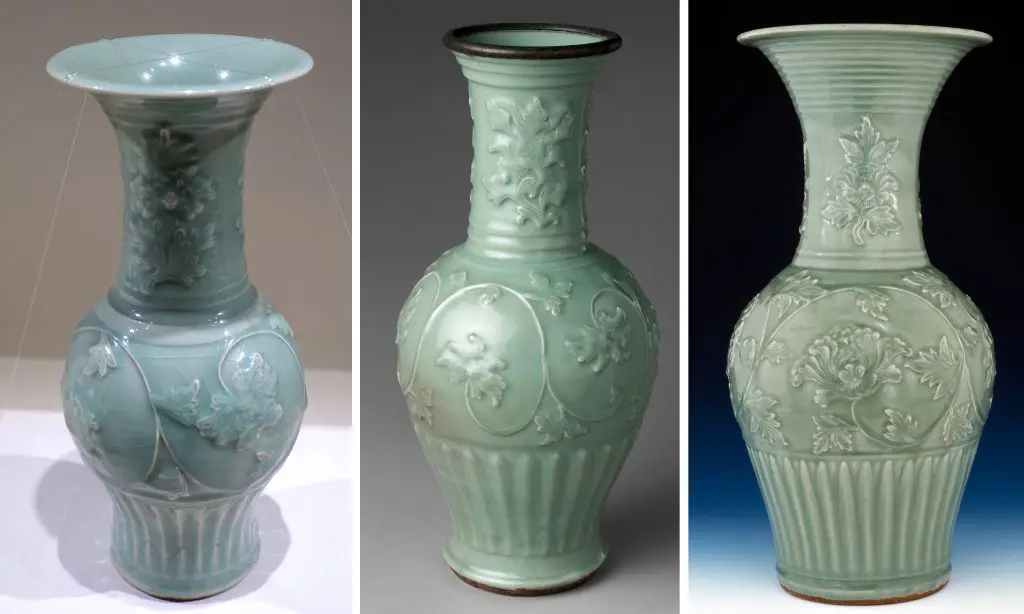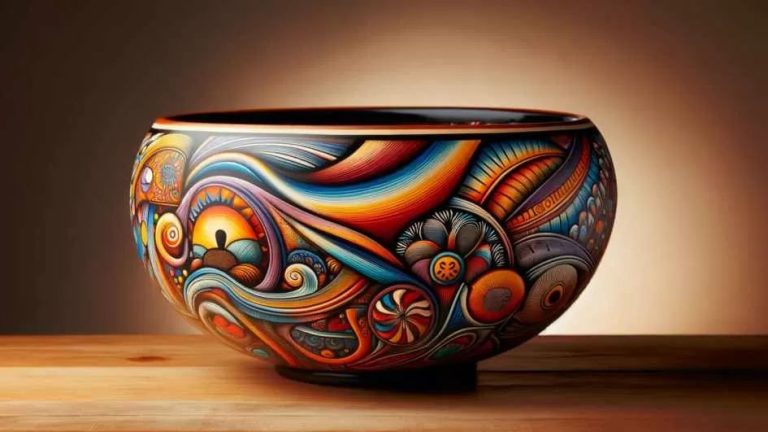What Does The Celadon Symbolize?
Celadon is a term used to describe ceramics glazed in various shades of pale green. The name comes from the French word “céladon”, which refers to the light green color. Celadon glazes were first developed in ancient China during the Eastern Han dynasty (25-220 CE), and celadon wares were highly prized by the imperial court. The ceramics produced were known for their elegant shapes and delicate jade-like colors.
Over time, celadon techniques spread to nearby regions including Korea and Japan. Each culture produced distinct celadon pieces, but all shared common qualities of fine pottery and a signature greenish glaze. Celadon became closely associated with cultural refinement and elegance across East Asia. The wares were cherished by elites for centuries and remain iconic artistic achievements today. This overview will explore celadon’s history, stylistic development, and enduring mystique across Chinese, Korean and Japanese ceramics.
Sources:
https://factsanddetails.com/china/cat7/sub40/entry-7575.html
Symbolism in Chinese Culture
In Chinese culture, the celadon glaze came to symbolize attributes viewed as ideal in ancient China. The soft, muted green hue was associated with nature, spirituality and humble living (Celadon. n.d.). Celadon ceramics emerged during the Song dynasty (960-1279 CE), and the celadon glaze was meant to mimic the color of jadeite, which was precious and rare at the time (What is Celadon Pottery? n.d.). Jade was revered in Chinese culture and thought to embody the virtues of wisdom, justice, compassion and modesty. The ability to mimic jade with humble ceramics spoke to Chinese ideals of living simply and in harmony with nature. Celadons also symbolized the more mystical aspects of Taoism, as the ceramics seemed to capture the living essence of nature in their fluid forms and evocative green tones.
Celadon Glazes

Celadon glazes refer to the pale green, greyish green or blue green glazes typically used on celadon ceramics. The distinguishing characteristics of celadon glazes are their color and their ability to allow subtle decoration from the clay body to show through.
The composition and production process of celadon glazes results in their unique aesthetic qualities. Typically, celadon glazes contain a high percentage of iron oxide, which provides the greenish color. They also utilize a wide range of other oxides like silica, alumina, potash, lime, magnesia and soda for their formulation [1]. The ingredients are finely ground and then mixed with water to produce the glaze slurry.
When fired in an oxidizing kiln at temperatures between 1200-1400 degrees Celsius, the iron oxide in the glaze formulation causes the pale greenish color while the glaze remains translucent due to the skillful balancing of the oxide composition. This translucent quality allows the plain, grayish color of the clay beneath to show through subtly, creating the distinctive celadon aesthetic.
Celadon Ceramics
Celadon glazes were used to decorate various types of ceramics in East Asia, especially during the Song dynasty in China (960-1279 CE). Common artifacts made with celadon glaze include vases, bowls, plates, ewers, incense burners, and figurines. Celadon glazes were considered particularly suitable for decorating ceramics used for scholars, due to their subtle and elegant colors.
One famous type of Chinese celadon from the Song period is Guan ware, which originated in Henan province. Guan wares were known for their sea-green glaze, carved decorations of dragons and phoenixes, and delicate craftsmanship using thin clay bodies (Source: https://en.wikipedia.org/wiki/Celadon). Longquan celadon produced in Zhejiang province was another major celadon type, characterized by pale green glazes and peach-bloom hues.
In Korea, Goryeo celadons produced during the Goryeo dynasty (918–1392) are considered the most refined and beautiful celadons ever produced. The glaze color ranged from pale green to deeper blue-greens, with crackle patterns that were prized. Common artifacts include vases, bowls, and boxes decorated with inlaid patterns. Goryeo celadons were highly valued trade items and spread across East Asia and Central Asia along trade routes (Source: https://study.com/academy/lesson/what-is-celadon-pottery-history-facts.html).
Symbolism in Korean Culture
In Korean culture, celadon ceramics have held deep symbolic meaning for centuries. The pale green color of Korean celadons symbolized beauty, spirituality, nobility and virtue to the Korean people. According to the Metropolitan Museum of Art (Goryeo Celadon | Essay – Metmuseum.org), the elegance of celadon glazes was unsurpassed in all of East Asia during the 12th and 13th centuries. The serene jade-like color represented the Confucian ideals of harmony, tranquility and cultivation of the spirit that were dominant during the Goryeo Dynasty when celadon production peaked. For Korean royalty and aristocrats, possessing fine celadon wares was a mark of sophistication, prestige and virtuous character.
Early Korean Celadons
The early Korean celadons, known as Goryeo celadons, were produced during the Goryeo dynasty between 918 and 1392 CE. The Goryeo celadons are regarded as some of the finest and most beautiful ceramics produced in Korean history.
The Goryeo potters mastered the jade-like bluish-green glaze that became known as traditional Korean celadon. According to the Ceramics Lifetips article Celadon (Cheong-Ja) – the Stuff of Kings, Goryeo celadons were coveted by Chinese emperors and the Korean court valued them as much as gold.
One of the unique techniques perfected by Goryeo potters was inlaid celadon. As explained in the AnyFlip article MAGAZINE, inlaid celadon involves carving delicate designs into the clay body before glazing and then inlaying these recesses with colored clay or slip. This produced intricate designs in contrasting colors underneath the celadon glaze.
The inlaid celadon wares, including vases, bowls, and lidded boxes, displayed complex floral patterns and traditional Buddhist iconography. These pieces demonstrated the outstanding technical mastery of the Goryeo potters and the aesthetic refinement of the Goryeo court.
Symbolism in Japanese Culture
In Japan, celadon became associated with the aesthetics of Zen Buddhism, which values simplicity, elegance, and harmony with nature. The subtle green tones and natural shapes of celadon ceramics were seen as embodying wabi-sabi, the Zen ideal of finding beauty in imperfection and transience.
Celadon production flourished in Japan during the Momoyama period (1573-1615) and Edo period (1615-1868), especially in Kyoto and Arita. The natural ash glazes used on Japanese celadons, known as seiji, created a soft, subtle green that was prized by tea masters and Zen monks [1]. The ceramics were used in the Japanese tea ceremony, which has strong connections to Zen principles.
Celadon came to symbolize spirituality, humility, and quiet refinement in Japanese culture. The subdued colors and imperfections in the glaze were appreciated for their expression of wabi-sabi ideals. Over time, Japanese celadons became some of the most celebrated ceramics in East Asia.
Japanese Celadon Production
Celadon production flourished in Japan during the Kamakura (1185-1333 CE) and Muromachi (1336-1573 CE) periods. The major production centers were located in Kyoto and Seto. According to the Encyclopedia Britannica article on celadon, the earliest dated Japanese celadon piece is from 1189 CE. Japanese celadons often featured unique glazes including the crackled Tobe-yaki style and the prized ocean green Seiji glaze.
The Tokoname and Shigaraki areas were known for producing a distinctive style of celadon with ash glazes in subtle earth tones. According to the Wikipedia article on celadon, Tokoname celadons frequently had stamped or incised decorative patterns. Japanese potters also developed new shapes and forms for celadon ceramics, diverging from Chinese prototypes. Distinctively Japanese celadon wares included flower vases, incense burners, and tea ceremony utensils.
Celadon Collecting
Celadon ceramics have been highly prized by collectors for centuries. Most collectible celadons come from the Song dynasty in China, the Goryeo dynasty in Korea, and the Heian to Edo periods in Japan. High-quality celadons from these eras can sell for thousands of dollars at auction. When assessing the value and quality of celadon wares, collectors look at several factors:
First, the glaze is key. The most desirable celadons have a smooth, even sea green glaze without imperfections. Subtle crackling or crazing in the glaze, known as “spider web” crazing, is also prized. Next, the shape of the vessel is important. Collectors favor classic forms like bowls, vases, and incense burners. Decoration is another marker of value – minimalist designs or light carving is preferred over heavily ornamented pieces. Lastly, provenance establishes authenticity. Celadons from renowned kilns or collections command higher prices. Though modern celadons are produced today, antiques from the Song, Goryeo, and Heian-Edo eras are the most coveted. With an understanding of celadon history and aesthetics, collectors can identify the finest museum-quality pieces.
Sources:
https://www.marks4antiques.com/term/Celadon
Conclusion
In summary, celadon has had enduring symbolic associations and an artistic legacy across East Asian cultures for over a millennium. Its origins in ancient Chinese kilns established key technical innovations like the celadon glaze that were adopted widely. As Korean and Japanese potters began producing celadons, the ceramics took on symbolic meanings of spirituality, nature, purity, and harmony in those cultural contexts.
The celadon glaze itself has been prized for its tranquil jade-like colors, carefully controlled through techniques like reduction firing. Master potters became renowned for their ability to create the perfect crackled or pooled effects in the glaze. While celadon production declined in later eras, there has been a revival of interest in traditional East Asian ceramics and a recognition of celadon’s historic importance.
Celadons from different eras and regions are now prized as cultural artifacts and works of art collected by museums and scholars worldwide. Their legacy is a testament to the technical achievements of ancient potters and the rich meanings celadons took on in China, Korea, and Japan.



